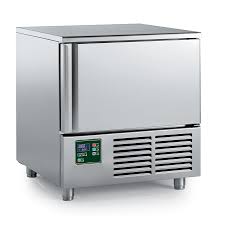Blast chillers are industrial refrigeration appliances that are used widely in the foodservice industry for quick and effective cooling of hot food items. They allow cooled or frozen storage of a wide variety of prepared foods, helping restaurants and kitchens serve fresh and safe food round the clock.
What are Blast Chillers?
A blast chiller is a specialized refrigerator appliance that uses a cold air distribution system to rapidly cool or ‘blast chill’ hot foods down to a safe temperature in a very short span of time. Unlike conventional refrigerators that cool food slowly from the outer surface inwards, blast chillers subject the food to extremely cold air currents (-31°C to 3°C) circulating at high velocities to transfer heat away from the food faster. This allows quick reduction of the food’s internal temperature, preventing the survival and growth of potential foodborne pathogens.
Working of a Blast Chiller
All Blast Chillers work on the principle of aggressive air circulation. They consist of a refrigeration unit, a cold air distribution system and insulated food cabinets. When switched on, the refrigeration unit generates very cold air which is then propelled through the distribution system into the insulated food cabinets using high velocity fans. The cold air circulates uniformly around the hot food in sealed food pans, drawing out heat from all surfaces simultaneously. Temperature probes inside monitor and automate the chilling cycle until the food reaches the preset safe temperature.
Types of Blast Chillers
Several types of blast chillers are available today to meet various commercial kitchen needs:
Reach-in Blast Chillers: These are cabinet-style appliances with one or more insulated food compartments that can be reached into from the front. They are best suited for smaller kitchens with occasional chilling needs.
Roller Cart Blast Chillers: Similar in functioning to reach-in models but mounted on a sturdy roller base for easy mobility within a kitchen. Ideal for medium-sized operations.
Walk-in Blast Chillers: Large refrigeration units designed for installation inside walk-in coolers and freezers. Suitable for high-volume commercial kitchens with substantial hourly chilling loads.
Spiral Blast Chillers: Continuous spiral conveyor allows automatic single-file processing of hanging food products like poultry and meats. Especially used by food processors and butchers.
Mobile Blast Chillers: Compact refrigeration units mounted on a trailer or truck for on-site chilling during events, shoots etc. Prove helpful in temporary locations.
Applications in the Food Industry
Given their rapid cooling capability, blast chillers find widespread use across the foodservice sector for chilling or freezing a diverse range of prepared foods, some key ones being:
– Soups, sauces and gravies which otherwise would continue cooking if left out for slow cooling.
– Cooked rice, pasta and grain dishes prone to bacterial growth in the “danger zone”.
– Sandwiches, salads and cooked vegetables to halt enzymatic actions and prevent sogginess.
– Roasted and braised meats tenderized through moist-heat cooking method.
– Baked goods like pastries, cakes and breads to prevent staling.
– Par-cooked or partially cooked products meant for quick rethermalization.
Blast Chilling Food Safety and Shelf Life Extension
The significantly faster drop in internal food temperature achieved through blast chilling has dramatic food safety implications compared to slower cooling methods. By reducing microbial growth opportunities, blast chilling kills or inhibits pathogenic bacteria to render food microbiologically safe. At the same time, it helps retain visual appeal, texture, flavor and nutritional value of foods much longer by slowing down natural deteriorative processes. This leads to extended refrigerator shelf life of 3-5 times or more for blast chilled prepared food items. Hence blast chilling delivers better safety, quality and cost savings for the foodservice industry.
*Note:
1. Source: Coherent Market Insights, Public sources, Desk research
2. We have leveraged AI tools to mine information and compile it




